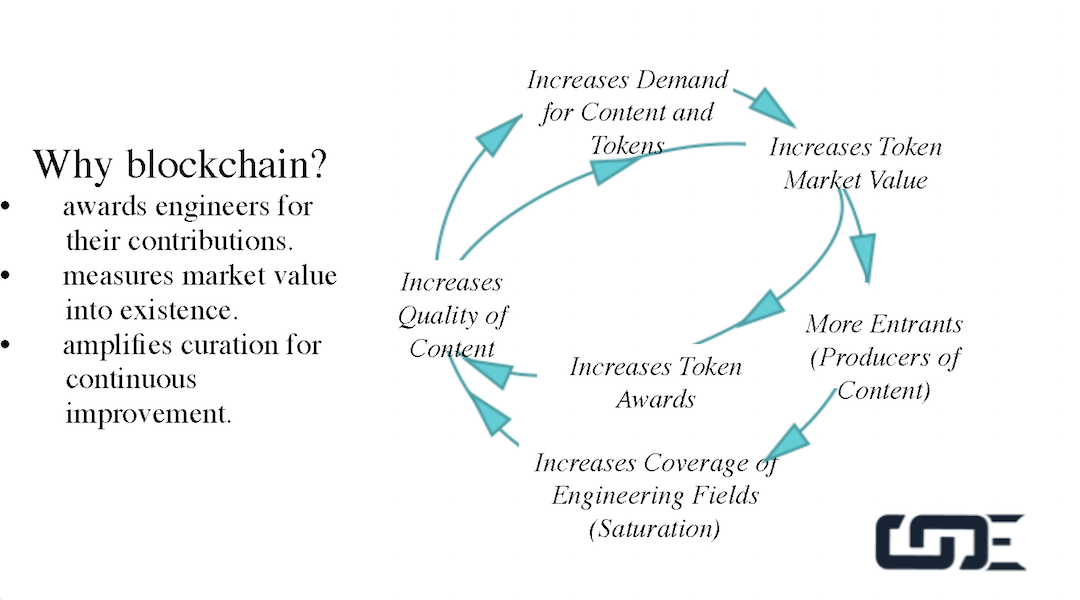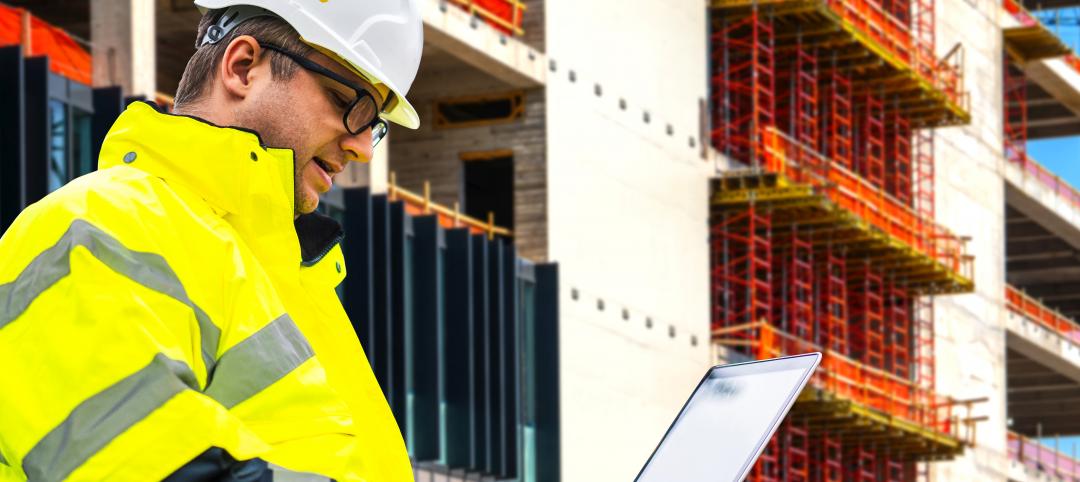Jacobs Engineering Group is in the vanguard of AEC firms that are committed to exploring the potential of blockchain technology for the construction industry.
The blockchain committee within Jacobs’ practice meets monthly and has discussed use cases ranging from the monetization of smart meter data to using blockchain for water compliance reporting. Jacobs is currently testing the applicability of blockchain for assessing the risk of equipment failure and predicting obsolescence, where the value of the blockchain’s information would derive from optimizing the process, balancing operating and capital expenditures by pooling knowledge, and showing evidence of cashflow improvements.
Its clients in the power industry want to know if blockchain could affect distributed power generation in areas like metering and billing. And the firm’s transportation group is gauging whether blockchain can be used to make toll payments and develop smart contracts.
Jacobs is also a co-founder of the Integrated Engineering Blockchain Consortium (IEBC), which last year launched its CoEngineers blockchain whose purpose is to price risk by establishing the value of engineering in the built environment.
None of these initiatives, however, is close to being fully realized, and there remain questions about blockchain’s efficacy versus other, more conventional transaction methods.
“We’re in the very early stages for our industry,” says Thomas Wendling, PE, Systems Manager in Jacobs’ Englewood, Colo., office. He notes specifically that CoEngineers has yet to come up with token functionality that is seminal to incentivizing a blockchain’s participants.
See Also: Blockchain: A primer
Still, Wendling has urged Jacobs’ innovation leadership to adopt CoEngineers as an experimental platform for finding and placing the right talent for its clients. CoEngineers, says Wendling, could be a first layer of a platform that ultimately gives the participating community access to collaborative BIM, and could also involve automated contracts for construction management and the Internet of Things (IoT).
Hopeful signs
Jacobs’ experiences with blockchain technology pretty much mirror where the rest of the industry seems to be at the moment: hopeful that blockchain might revolutionize the industry’s transactional relationships, but also frustrated that blockchain’s development for the construction industry isn’t evolving more rapidly—or has yet to attract anywhere near the interest or investment that the industry has been lavishing on, say, artificial intelligence.
Optimists within the AEC industry can point to the fact that blockchain technology is gaining wider acceptance within financial and banking spheres, and that several brand name companies, such as Walmart and Nike, are using or exploring how blockchain can enhance their supply chains.
The construction industry isn’t ignoring this trend, either. On its website last April, eSub Construction Software, which provides construction management software for subcontractors, posted an article that portrayed blockchain and construction as a “natural pairing” that boils down to four steps: project modeling, smart contracts, inspections, and delivery. The successful verified completion of each step would lead to expedited payments.
Last September, Brickchain, a Los Angeles-based data management and blockchain firm, signed its largest-to-date supply chain management agreement with ProBuild, one of Australia’s largest construction firms. Brickchain’s suite of blockchain applications helps contractors track their assets and streamline facilities management. In ProBuild’s case, its blockchain is triggered by Ynomia’s BLEAT IoT technology, which physically connects and tracks construction site resources with sensor networks.
For the past three years, Don Bowden, a former subcontractor, has been developing BuilderChain, which uses blockchain technology to efficiently confirm and verify information about homebuilding subs that, ideally, would reduce or even eliminate the paperwork subs fill out when they’re bidding for jobs.
Bowden explains that contractors would issue validation tokens after subs and suppliers verified their bona fides. And once a contract is awarded, the GC would use commitment tokens for a micro-draw system for paying subs by task or project. Bowden says he’s planning to create a third-party merchant that would provide the validation service and issue tokens.
BuilderChain’s blockchain could also record “reputational” information about a project’s scheduling patterns, inspection history, and other product issues. Right now, Bowden’s blockchain is focused on residential GCs, but he foresees applications for nonresidential contractors, too.
 The CoEngineers blockchain would create a market for “tokens” that engineers could sell at a premium to parties (e.g., developers or owners) interested in accessing information about the engineers’ validated contributions to a project. Courtesy IEBC.
The CoEngineers blockchain would create a market for “tokens” that engineers could sell at a premium to parties (e.g., developers or owners) interested in accessing information about the engineers’ validated contributions to a project. Courtesy IEBC.
‘Fear of change’ still a barrier
Joan Zhong-Brisbois, PhD, PE, a bridge engineer with WSP USA in Seattle, sees blockchain as a way to make the design process more efficient for projects related to transportation by facilitating a “knowledge transaction” and reducing the friction within a project. In early 2019, WSP planned to embark on a test that would use blockchain “like a handshake,” she says, for validating agreements and consensus.
Zhong-Brisbois acknowledges that a broader application of blockchain technology requires a cultural shift “in how we think and what we do.” There are “competing interests” that need to be assuaged, and IP protections that need to be sorted out. The biggest roadblock, she says, is the industry’s “inertia” and “fear of change.”
Arup has been studying blockchain since 2013. And in early February, the firm released its second research report about this technology, examining blockchain’s use in five sectors: cities, property, transportation, water, and energy.
“Blockchain has not been a transformative disruption for the AEC industry yet, but we are seeing early use cases emerging and showing real promise,” says Bella Nguyen, PhD, Senior Research Consultant in Arup’s London office.
Nguyen thinks more testing is needed before users can make informed decisions about blockchain and the specific problems it might solve. The industry also needs to get a better handle on the types of products and services that can be built on top of the infrastructure. “Without an infrastructure in place, we won’t be able to unlock the true potential of blockchain,” she says.
That being said, several of Arup’s clients are already expressing interest in blockchain as an autonomous decentralized system that eliminates middlemen to reduce transaction costs and facilitate greater exchange. Arup’s research indicates that early adoption within the AEC industry might begin in earnest in 2025. “The trajectory of blockchain is quite clear. But in this industry, it’s not going to happen overnight,” says Nguyen.
Revaluing engineers by pricing risk
Can blockchain reframe how the industry values work? That’s what Daniel Robles, PE, a former Boeing engineer and founder of the Integrated Engineering Blockchain Consortium, is trying to discern.
Robles’ thesis is that infrastructure is a value “upon which we utterly depend.” Engineers play a critical role in reducing risk in infrastructure projects. But engineering value is “invisible,” he contends. “How many airplanes do not crash? How many buildings do not burn? You cannot directly measure an event that never happens,” he says.
Consequently, engineering is undervalued, and engineers take a back seat in calculating risk to bankers, developers, politicians, and other entities whose traditional metrics—land, labor, and capital—often don’t provide complete information.
Robles views blockchain technology as a tool that can measure risk, with the engineer as the focal point. His CoEngineers blockchain is set up to do just that. He notes that one of the industry’s problems is that “there’s no Big Data for measuring engineering for life cycle analysis. The challenge is to get enough data into a database.”
To feed that database, the CoEngineers system uses game theory to create two kinds of incentives. First, an engineer makes a claim and receives a “mass” token. Then, another engineer verifies that claim and receives a “gravity” token. Mass tokens can be sold on an exchange, but gravity tokens represent reputation, and serve as a variable for calculating the payout of mass tokens.
“CoEngineers is a peer-to-peer transaction between two engineers, nothing more and nothing less,” explains Robles.
And since gravity tokens can’t be traded, the incentive to purchase influence is eliminated. The blockchain acts as a “big clock,” against which all of these transactions are synchronized. “So now we can visualize the value, and with a time function, we can use quantitative analysis to derive all sorts of valuable information,” he says.
Insurers, lenders, and developers would purchase tokens to gain access to this information, which they could use, suggests Robles, to assess the life of the building and its component parts, say, after a flood or during the sale. The value of the tokens would rise or fall depending on demand and urgency. And because engineers are selling tokens, they would receive a dividend for the assessed value of their work.
The integrity of the system is enhanced by “witnesses” who have exact copies of the database, thereby thwarting cyber attacks. Witnesses are also block producers on a Delegated Proof of Stake chain, but without the energy requirements.
Witnesses generally would have an intrinsic incentive to preserve the integrity of the blockchain. Jacobs’ Wendling estimates that when fully functional, CoEngineers could have as many as 100 witnesses.
“What this system is trying to do is simple: pricing risk,” says Robles. And the engineer’s new role, via blockchain, would be as an “adjudicator” of risk who reconciles the physical world with the virtual world. “We cannot cede blockchain to computers.”
Aggregating trustworthy data
IEBC has raised enough money to build CoEngineers as its operational blockchain and “test bed.” The consortium has approached several professional associations—including the National Society of Professional Engineers—as well as CETYS University in Mexico about running witness nodes on the CoEngineers blockchain.
Robles spends much of his time proselytizing CoEngineers and IEBC via presentations and attending events like IBM’s Think 2019 Conference in February. IEBC has gotten this far operating on a shoestring budget, and is trying to raise new capital from engineering, financial, and insurance sources to advance its research and development. AEC firms, so far, “have been slow, or cautious” to invest, he states.
Such investment, Robles contends, is a lot cheaper than what companies would spend to develop their own blockchains. Coming up with a better mousetrap to measure risk is essential, he says, because the industry is at a crossroads “of digital twin and its physical siblings. You need engineers on the ground to validate that the siblings [i.e., sensors] are working and providing accurate data.”
Nyugen says that Arup is unlikely to build its own blockchain or participate in other platforms until the technology is refined. But she anticipates an eventual nexus of blockchain, BIM, and “the next wave of IoT.” And if blockchain becomes a big database, “can we apply machine learning to it?,” she asks.
That’s one of several questions the AEC industry is pondering as it lurches, slowly, toward this technology.
Related Stories
Concrete Technology | Apr 19, 2022
SGH’s Applied Science & Research Center achieves ISO 17025 accreditation for concrete testing procedures
Simpson Gumpertz & Heger’s (SGH) Applied Science & Research Center recently received ISO/IEC17025 accreditation from the American Association for Laboratory Accreditation (A2LA) for several concrete testing methods.
Sponsored | BD+C University Course | Apr 19, 2022
Multi-story building systems and selection criteria
This course outlines the attributes, functions, benefits, limits, and acoustic qualities of composite deck slabs. It reviews the three primary types of composite systems that represent the full range of long-span composite floor systems and examines the criteria for their selection, design, and engineering.
Wood | Apr 13, 2022
Mass timber: Multifamily’s next big building system
Mass timber construction experts offer advice on how to use prefabricated wood systems to help you reach for the heights with your next apartment or condominium project.
AEC Tech | Apr 13, 2022
Morphosis designs EV charging station for automaker Genesis
LA-based design and architecture firm Morphosis has partnered with automotive luxury brand Genesis to bring their signature brand and styling, attention-to-detail, and seamless customer experience to the design of Electric Vehicle Charging (EVC) Stations.
AEC Tech | Apr 13, 2022
A robot automates elevator installation
Schindler—which manufactures and installs elevators, escalators, and moving walkways—has created a robot called R.I.S.E. (robotic installation system for elevators) to help install lifts in high-rise buildings.
Modular Building | Mar 31, 2022
Rick Murdock’s dream multifamily housing factory
Modular housing leader Rick Murdock had a vision: Why not use robotic systems to automate the production of affordable modular housing? Now that vision is a reality.
Building Technology | Feb 28, 2022
BIPV and solar technology is making its mark in the industry
Increasingly, building teams are comparing the use of building-integrated photovoltaic (BIPV) systems for façades, roofs, and other architectural assemblies with a promising and much easier alternative: conventional solar panel arrays, either on their building or off-site, to supplement their resiliency and decarbonization efforts
Sponsored | BD+C University Course | Feb 17, 2022
Metal roofing trends
New ideas in design and constructability are radically changing how metal systems are used as roofing for commercial and institutional buildings. Behind the investment in these new kinds of expressions and construction approaches is a growing interest in improved performance and reduced environmental impact. Metal roofing systems can cut cooling and heating loads significantly, according to the EPA.
M/E/P Systems | Jan 27, 2022
Top 5 building HVAC system problems and how to fix them
When your HVAC system was new, it was designed to keep the indoor environment comfortable, functional, and safe. Over time, that system can drift out of alignment, leading to wasted resources, excessive energy consumption, and reduced occupant comfort.
Sponsored | Voice of the Brand | Jan 27, 2022
A Modern Approach to Labor in the Construction Industry
The COVID-19 pandemic disrupted and reshaped norms in the workforce and the ongoing labor shortage can be felt in every industry. Innovations to go faster, maintain safety, minimize learning curves, and drive down costs are becoming imperatives for companies to stay competitive in the construction industry.
















